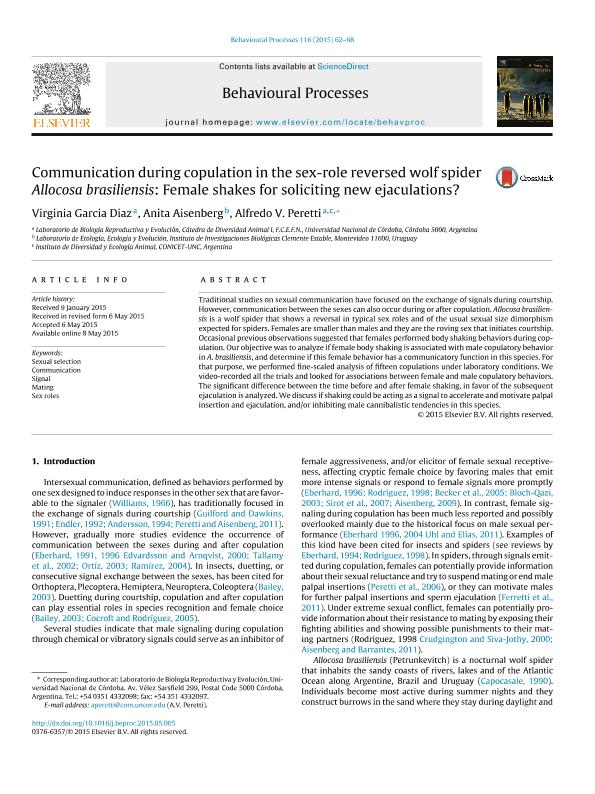Mostrar el registro sencillo del ítem
dc.contributor.author
Garcia Diaz, Virginia
dc.contributor.author
Aisenberg, Anita
dc.contributor.author
Peretti, Alfredo Vicente

dc.date.available
2016-11-04T20:16:00Z
dc.date.issued
2015-05
dc.identifier.citation
Garcia Diaz, Virginia; Aisenberg, Anita; Peretti, Alfredo Vicente; Communication during copulation in the sex-role reversed wolf spiderAllocosa brasiliensis: Female shakes for soliciting new ejaculations?; Elsevier Science; Behavioural Processes; 116; 5-2015; 62-68
dc.identifier.issn
0376-6357
dc.identifier.uri
http://hdl.handle.net/11336/7997
dc.description.abstract
Traditional studies on sexual communication have focused on the exchange of signals during courtship.However, communication between the sexes can also occur during or after copulation. Allocosa brasilien-sis is a wolf spider that shows a reversal in typical sex roles and of the usual sexual size dimorphismexpected for spiders. Females are smaller than males and they are the roving sex that initiates courtship.Occasional previous observations suggested that females performed body shaking behaviors during cop-ulation. Our objective was to analyze if female body shaking is associated with male copulatory behaviorin A. brasiliensis, and determine if this female behavior has a communicatory function in this species. Forthat purpose, we performed fine-scaled analysis of fifteen copulations under laboratory conditions. Wevideo-recorded all the trials and looked for associations between female and male copulatory behaviors.The significant difference between the time before and after female shaking, in favor of the subsequentejaculation is analyzed. We discuss if shaking could be acting as a signal to accelerate and motivate palpalinsertion and ejaculation, and/or inhibiting male cannibalistic tendencies in this species.
dc.format
application/pdf
dc.language.iso
eng
dc.publisher
Elsevier Science

dc.rights
info:eu-repo/semantics/openAccess
dc.rights.uri
https://creativecommons.org/licenses/by-nc-nd/2.5/ar/
dc.subject
Sexual Selection
dc.subject
Communication
dc.subject
Signal
dc.subject
Sex Roles
dc.subject.classification
Zoología, Ornitología, Entomología, Etología

dc.subject.classification
Ciencias Biológicas

dc.subject.classification
CIENCIAS NATURALES Y EXACTAS

dc.title
Communication during copulation in the sex-role reversed wolf spiderAllocosa brasiliensis: Female shakes for soliciting new ejaculations?
dc.type
info:eu-repo/semantics/article
dc.type
info:ar-repo/semantics/artículo
dc.type
info:eu-repo/semantics/publishedVersion
dc.date.updated
2016-11-02T18:12:46Z
dc.journal.volume
116
dc.journal.pagination
62-68
dc.journal.pais
Países Bajos

dc.journal.ciudad
Amsterdam
dc.description.fil
Fil: Garcia Diaz, Virginia. Universidad Nacional de Cordoba. Facultad de Cs.exactas Fisicas y Naturales. Catedra de Diversidad Animal I; Argentina
dc.description.fil
Fil: Aisenberg, Anita. Instituto de Invest. Biologicas "clemente Estable"; Uruguay
dc.description.fil
Fil: Peretti, Alfredo Vicente. Universidad Nacional de Cordoba. Facultad de Cs.exactas Fisicas y Naturales. Catedra de Diversidad Animal I; Argentina. Consejo Nacional de Investigaciones Cientificas y Tecnicas. Centro Cientifico Tecnologico Cordoba. Instituto de Diversidad y Ecologia Animal; Argentina
dc.journal.title
Behavioural Processes

dc.relation.alternativeid
info:eu-repo/semantics/altIdentifier/doi/http://dx.doi.org/10.1016/j.beproc.2015.05.005
dc.relation.alternativeid
info:eu-repo/semantics/altIdentifier/url/http://www.sciencedirect.com/science/article/pii/S037663571500128X
Archivos asociados
